AUDI Q3 2015 Owners Manual
Manufacturer: AUDI, Model Year: 2015, Model line: Q3, Model: AUDI Q3 2015Pages: 258, PDF Size: 64.9 MB
Page 131 of 258
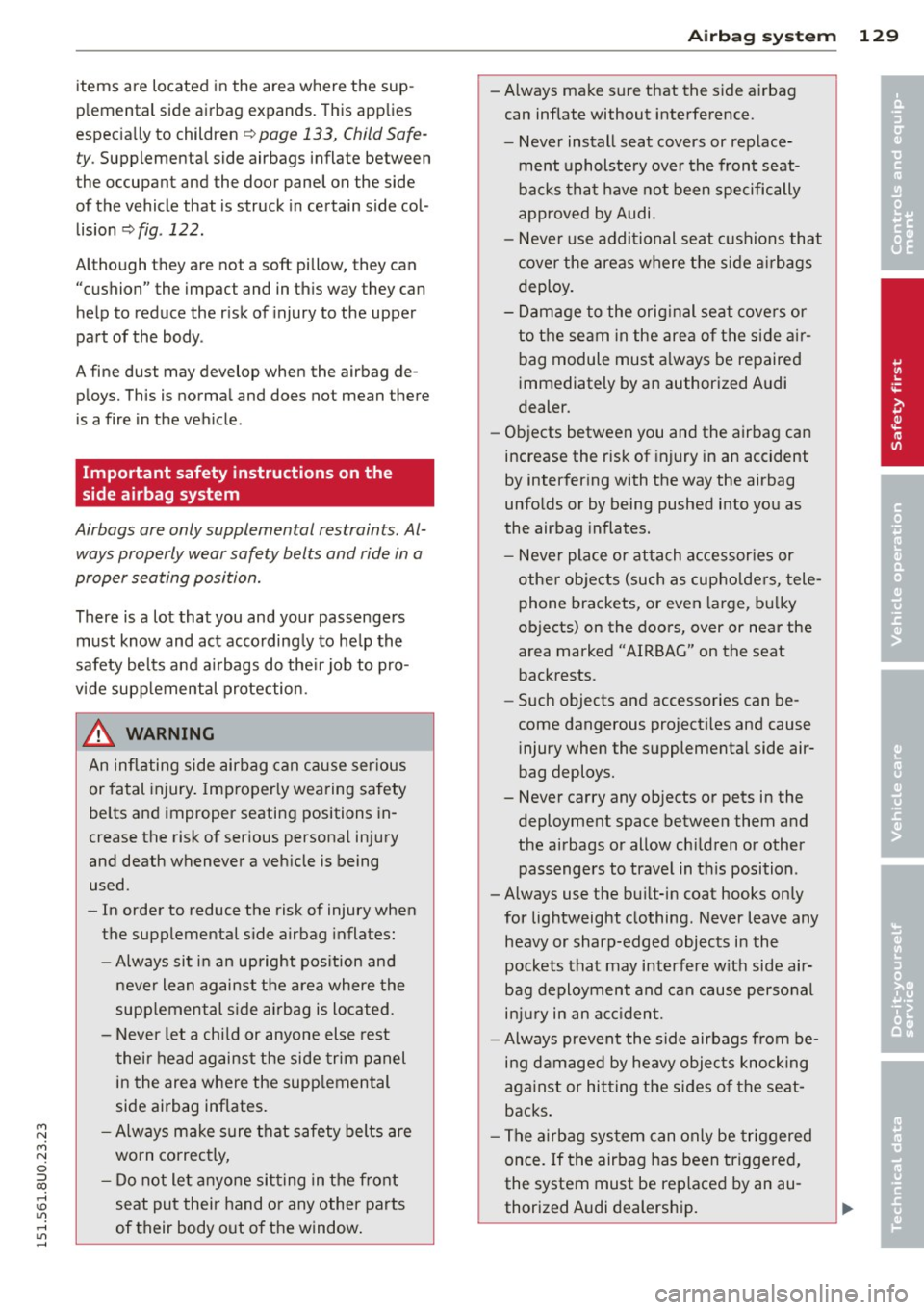
M N
M N
0 ::i co ,...., \!) 1.1'1 ,...., 1.1'1 ,....,
items are located in the area where the sup
plemental side airbag expands. This applies
especially to children ¢
page 133, Child Safe
ty.
Supplemental side airbags inflate between
the occupant and the door panel on the side
of the vehicle that is struck in certain side col
lision
¢ fig . 122.
Although they are not a soft pillow, they can
"cushion" the impact and in this way they can
help to reduce the risk of injury to the upper
part of the body .
A fine dust may develop when the airbag de
ploys. This is normal and does not mean there
is a fire in the vehicle .
Important safety instructions on the
side airbag system
Airbags are only supplemental restraints. Al
ways properly wear safety belts and ride in a
proper seating position.
There is a lot that you and your passengers
must know and act accordingly to help the
safety belts and airbags do their job to pro
vide supplemental protection.
_& WARNING
An inflating side airbag can cause serious or fatal injury. Improperly wearing safety
belts and improper seating positions in
crease the risk of serious personal injury
and death whenever a vehicle is being
used.
- In order to reduce the risk of injury when
the supplemental side airbag inflates:
- Always sit in an upright position and
never lean against the area where the
supplemental side airbag is located.
- Never let a child or anyone else rest
their head against the side trim panel
in the area where the supplemental
side airbag inflates.
- Always make sure that safety belts are
worn correctly,
- Do not let anyone sitting in the front
seat put their hand or any other parts
of their body out of the window.
Airbag system 129
-Always make sure that the side airbag
can inflate without interference.
- Never install seat covers or replace
ment upholstery over the front seat
backs that have not been specifically
approved by Audi.
- Never use additional seat cushions that
cover the areas where the side airbags
deploy.
- Damage to the original seat covers or
to the seam in the area of the side air
bag module must always be repaired
immediately by an authorized Audi
dealer.
- Objects between you and the airbag can
increase the risk of injury in an accident
by inter fering with the way the airbag
unfolds or by being pushed into you as
the airbag inflates.
- Never place or attach accessories or
other objects (such as cupholders, tele
phone brackets, or even large, bulky
objects) on the doors, over or near the
area marked "AIRBAG" on the seat
backrests.
- Such objects and accessories can be
come dangerous projectiles and cause
injury when the supplement al side air
bag deploys.
- Never carry any objects or pets in the
deployment space between them and
the airbags or allow children or other
passengers to travel in this position .
- Always use the built-in coat hooks only
for lightweight clothing . Never leave any
heavy or sharp-edged objects in the
pockets that may interfere with side air
bag deployment and can cause personal
injury in an accident.
- Always prevent the side airbags from be
ing damaged by heavy objects knocking
against or hitting the sides of the seat
backs.
- The airbag system can only be triggered
once. If the airbag has been triggered,
the system must be replaced by an au
thorized Audi dealership.
•
•
Page 132 of 258
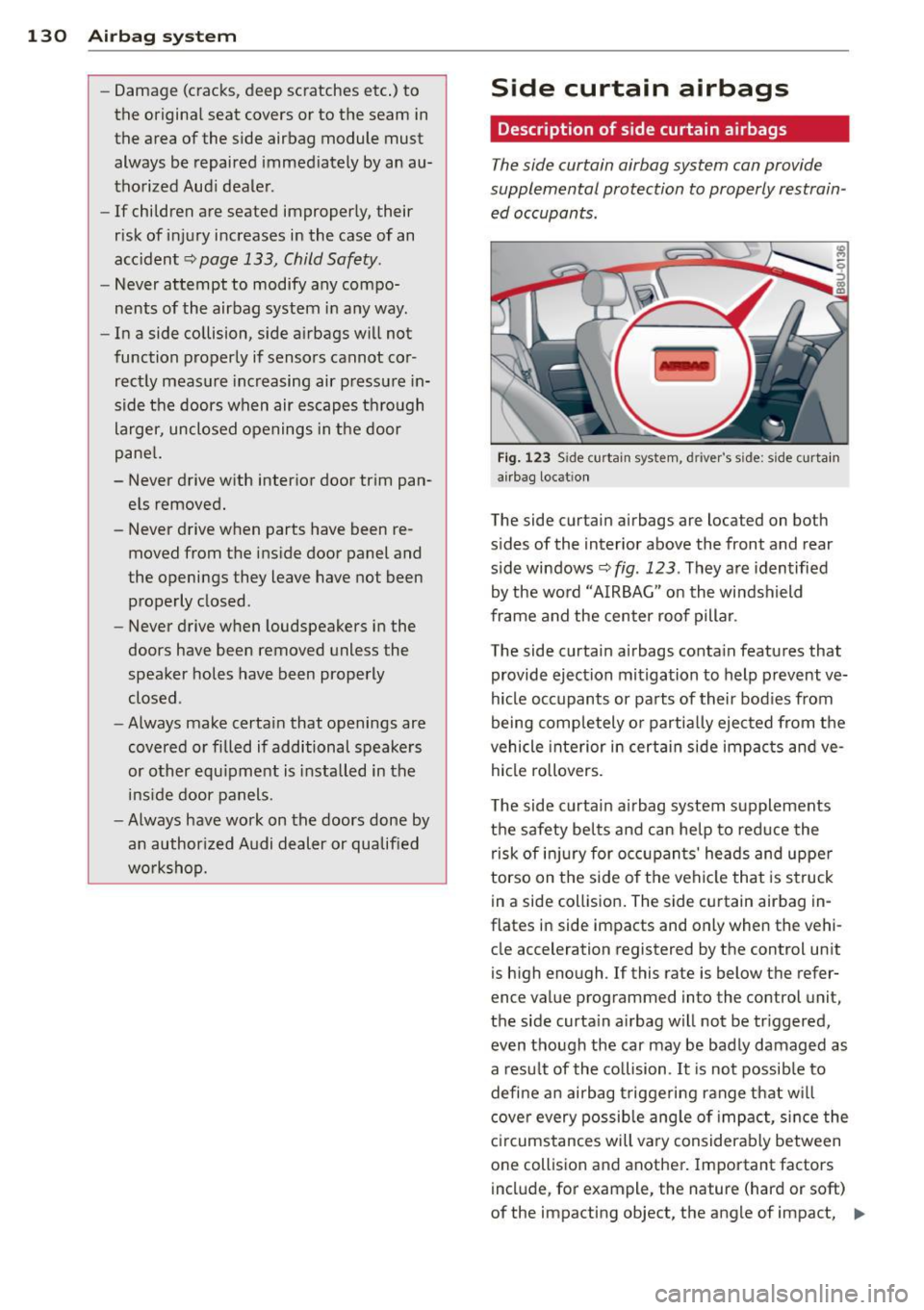
130 Airbag system
-Damage (cracks , deep scratches etc .) to
the original seat covers or to the seam in the area of the side airbag module must
always be repaired immediately by an au
thorized Aud i deale r.
- If children are seated improperly, their
risk of injury increases in the case of an
acc ident ~
page 133, Child Safety .
-Never attempt to modify any compo
nents of the airbag system in any way .
- In a side collision, s ide a irbags will not
function properly if sensors cannot cor
rectly measure increasing air pressu re in
side the doors when air escapes thro ugh
larger, unclosed openings in the door
pane l.
- Never drive with inter ior door trim pan
els removed.
- Never drive when parts have been re
moved from the ins ide door panel and
the openings they leave have not been
properly closed.
- Never drive when loudspeakers in the
doors have been removed unless the
speaker holes have been properly
closed .
- Always make certa in that openings are
covered or filled if additional speake rs
or other equ ipment is installed in the
ins ide door panels.
- Always have work on the doors done by
an author ized Audi dealer or qualif ied
wo rkshop.
Side curtain airbags
Description of side curtain airbags
The side curtain airbag system can provide
supplemental protection to properly restrain
ed occupants.
Fig . 123 S ide curta in s ystem, d river 's s ide: side curt ain
airbag locat io n
The side curta in airbags are located on both
s ides of the interior above the front and rear
s ide windows ~
fig. 123. They are identified
by the word "AIRBAG" on the windshield
frame and the center roof pillar .
The side curta in airbags conta in featu res that
provide ejection mitigation to help prevent ve
hicle occupants or parts of their bod ies from
being comp letely o r partia lly ejected from the
vehicle interior in certai n side impa cts and ve
hicle rollovers.
The side curtain airbag system supplements
the safety belts and can help to red uce the
risk of in jury for occ upants ' heads and uppe r
torso on the side of the vehicle that is struck
in a side collision. The side curtain a irbag in
flates in side impacts and only when the vehi cle acceleration registered by the control unit
is h igh enough . If this rate is below the refer
ence value programmed into the con trol unit,
the side curta in a irbag w ill not be tr iggered,
even though the car may be badly damaged as
a resu lt of the co llision .
It is not possib le to
define an airbag triggering range that w ill
cover every possib le ang le o f impac t, since the
c ircumstances will va ry considerably between
one collision and another. Important factors
incl ude, for example, the nature (hard or soft)
of the impacting object, the angle of impact, ""
Page 133 of 258
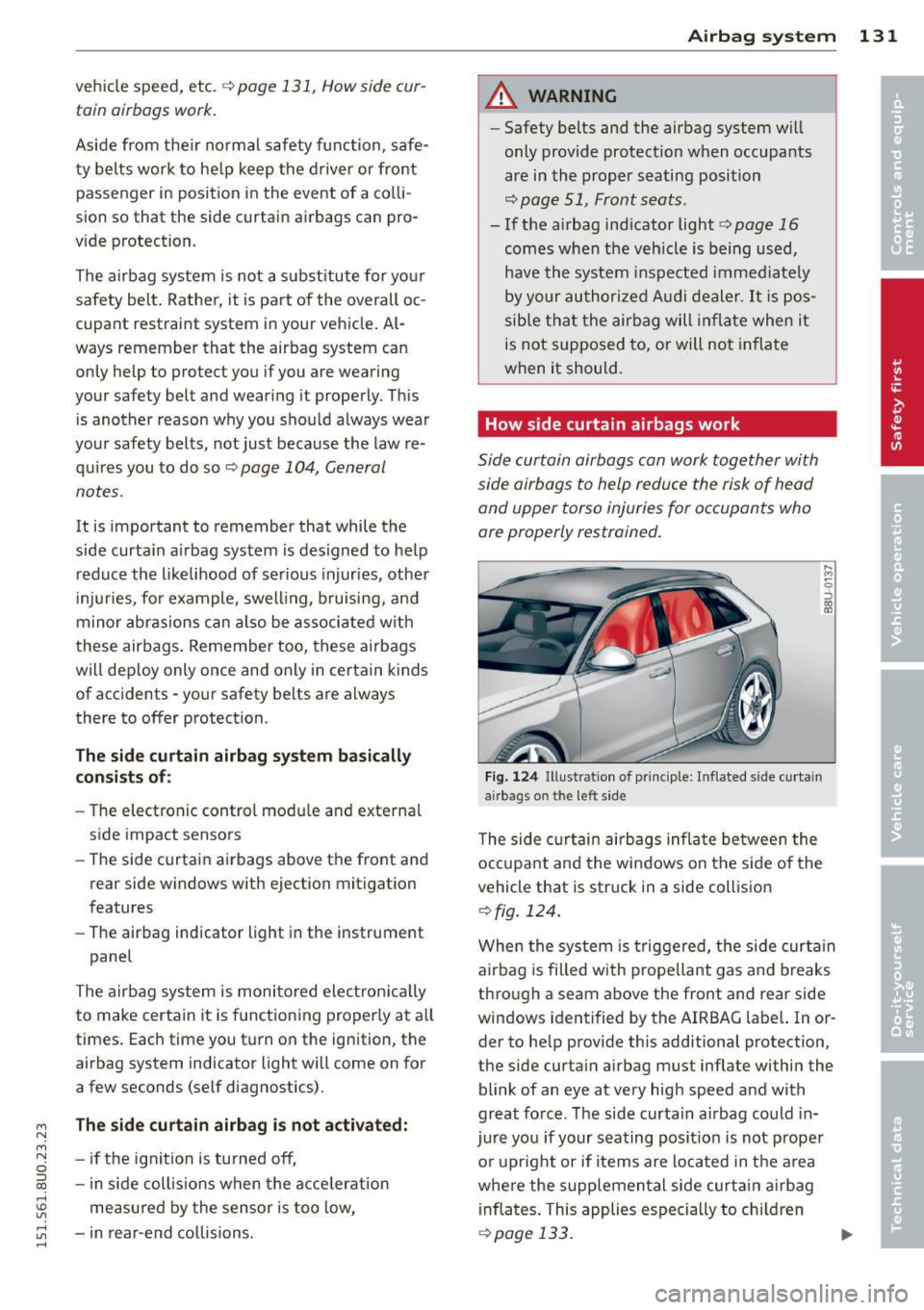
M N M N
0 ::i co
rl I.O
"' rl
"' rl
vehicle speed, etc. c> page 131, How side cur
tain airbags work .
Aside from their normal s afety func tion, safe
t y belts work to he lp keep the d river or front
passenger in position in the event of a co lli
sion so that the side curtain airbags can pro
vide protection.
The airbag system is not a s ubst itute for yo ur
safety be lt . Rather, it is part of the overall oc
cupant restraint system in your vehicle . Al
ways remember that the airbag system can
only help to protect you if you are wearing
your safety belt and wear ing it properly. Th is
is another reason why you shou ld always wear
your safety belts, not just beca use the law re
qu ires you to do so
c> page 104, General
notes.
It is important to remember that while the
side curta in a irbag system is designed to he lp
reduce the like lihood of serious injuries, other
i n ju ries, for example, swell ing, b ruising, and
minor abras ions can also be associated w ith
these airbags . Remember too, these a irbags
will dep loy only once and only in certain kinds
of accidents - yo ur safety belts are a lways
there to offer protection.
The side curtain airbag system basically
con sis ts of:
- The electronic contro l mod ule and externa l
s ide impact sensors
- The side curtai n airbags above t he front and
rear side windows with ejection mitigation
features
- The airbag indicator light in the instrument
panel
The a irbag system is monitored ele ct ron ic all y
to make certain it is functioning properly at a ll
times. Eac h time you turn on the ignition, the
airbag system indicator light will come on for
a few seconds (se lf diagnostics).
The side curtain airbag is not activated:
- if th e ign it io n is turned off,
- i n s ide collisions when the accelerat ion
measure d by the sensor is too low,
- in rear-end co llisions.
A irba g sy stem 131
A WARNING
-Safety belts and the airbag system will
only provide protection w hen occupants
are in th e proper seating position
c> page 51, Front seats .
- If the airbag indicator light c> page 16
comes when the veh icle is being used,
have the system inspe cted immediately
by your authori zed A udi dealer .
It is pos
sib le t hat the airbag will inflate when i t
is not supposed to, or will not inflate
when it should.
How side curtain airbags work
Side curtain airbags can work together with
side airbags to help reduce the risk of head and upper torso injuries for occupants who
are properly restrained .
Fig. 124 Illust rat io n of p rinciple: I nfla ted s ide cur tai n
a irbags on the left s ide
T he side c urta in airbags inflate be twee n the
occupant and the windows on the s ide of the
vehicle that is struck in a side collision
<=> fig. 124 .
When the system is t rigge red, the side curta in
a irbag is filled with propellant gas and b reaks
th ro ugh a seam above the front and rear side
windows identified by the AIRBAG labe l. In or
der to he lp provide this additional protection,
the side curta in a irbag must inflate within the
blink of an eye at very high speed and with
great fo rce . The side curta in a irbag could in
jur e you if your sea ting pos it io n is not prope r
o r uprig ht or if items are located in t he a rea
whe re the supplemen tal side curta in a irbag
infla tes . This applies espe cially to ch ildren
<=> page 133. II--
Page 134 of 258
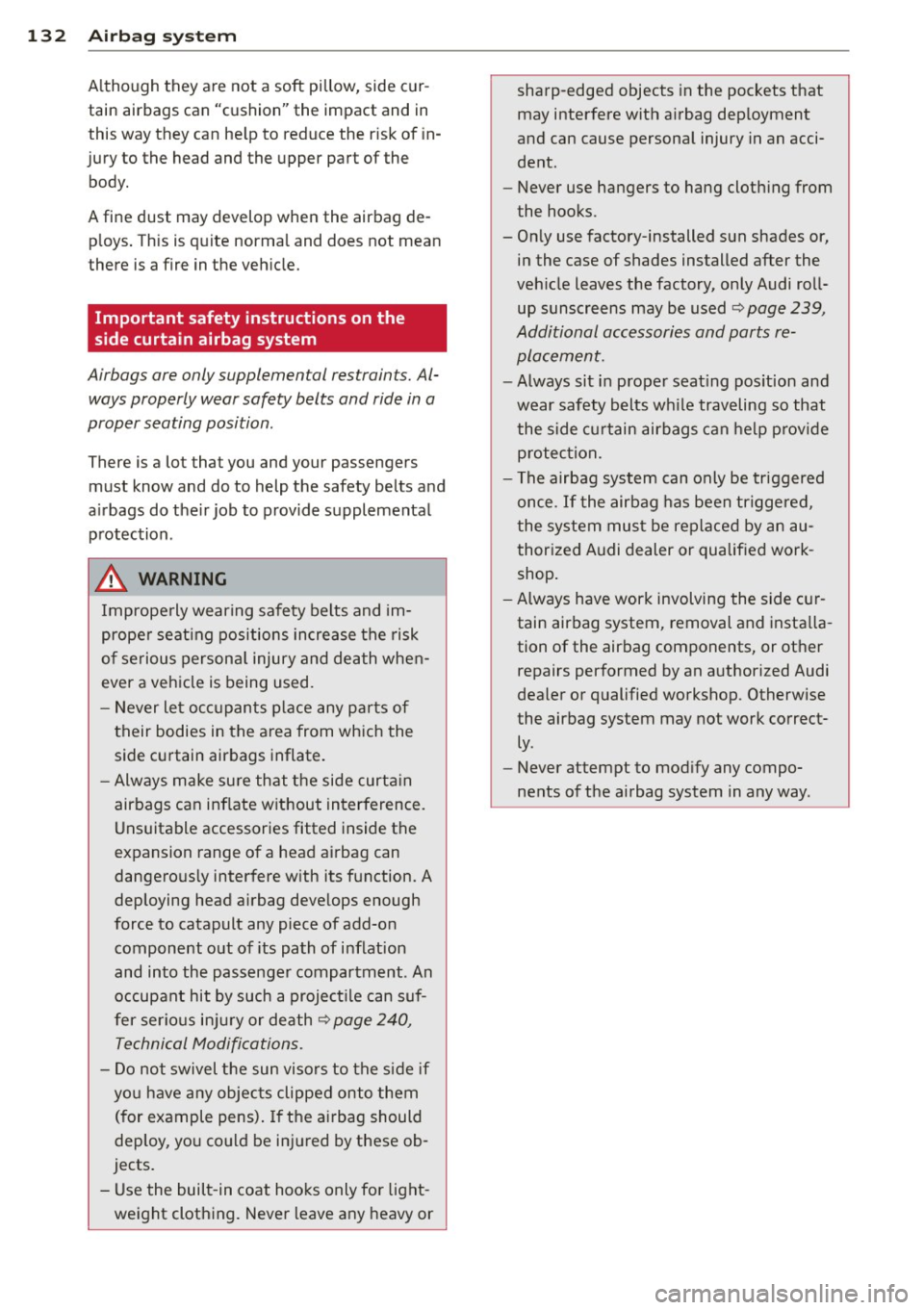
132 Airbag sys te m
Although they are not a soft pillow, side cur
tain airbags can "cushion" the impact and in
this way they can he lp to reduce the r isk of in
jury to the head and the upper part of the body.
A fine dust may develop when the airbag de p loys . This is q uite norma l and does not mean
there is a fire in the veh icle.
Important safety instructions on the
side curtain airbag system
Airbags are only supplemental restraints. Al
ways properly wear safety belts and ride in a
proper seating position .
There is a lot that you and your passengers
must know and do to help the safety belts and
a irbags do the ir job to provide supplemental
protection .
A WARNING
-
Improperly wearing safety belts and im
prope r seat ing positions increase the risk
of serious personal injury and death when
ever a veh icle is being used.
- Never le t occ upants p lace any p art s of
their bodies in the area from wh ich the
side curtain airbags inflate.
- Always make su re that the side curta in
airbags can inflate w ithout interference.
Unsuitable accessories fitted inside the
expansion range of a head a irbag can
dangero usly interfere w ith its function. A
deploying head a irbag develops enough
force to catapult any piece of add-on component out of its path of inflation
and into the passenger compartment . An
occupant hit by such a project ile can suf
fer serio us inju ry or de ath
~page 240,
Technical Modifications.
- Do not swivel the su n visors to the side if
yo u have any objec ts clipped onto them
( f or example pens) . If the a irbag should
deploy, you co uld be in jured by these ob
jects.
- Use the built -in coat hoo ks only for light
weight clothing. Neve r leave any heavy or sharp-edged objects
in the pockets that
may interfere with a irbag dep loyment
and can cause personal injury in an acci
dent.
- Never use hangers to hang cloth ing from
the hooks.
- On ly use factory-installed sun shades or,
in the case of shades installed after the
veh icle leaves the factory, only Audi roll
up sunscreens may be used
~ page 239,
Additional accessories and parts re
placement.
- Always sit in p roper seat ing pos ition and
wear safety belts wh ile traveling so that
the side cu rtain airbags can help p rov ide
p rotec tion.
- T he airbag system can only be triggered
once.
If the airbag has been triggered,
the system must be replaced by an au
thor ized Audi dealer or qualif ied work
shop .
- Always have work involving the side cu r
tain airbag system, removal and insta lla
tion of the airbag components, or other repairs per formed by an authorized Audi
dealer or qualified workshop. Otherwise
the airbag system may not work correct
ly.
- Never attempt to mod ify any compo
nents of the airbag system in any way .
Page 135 of 258
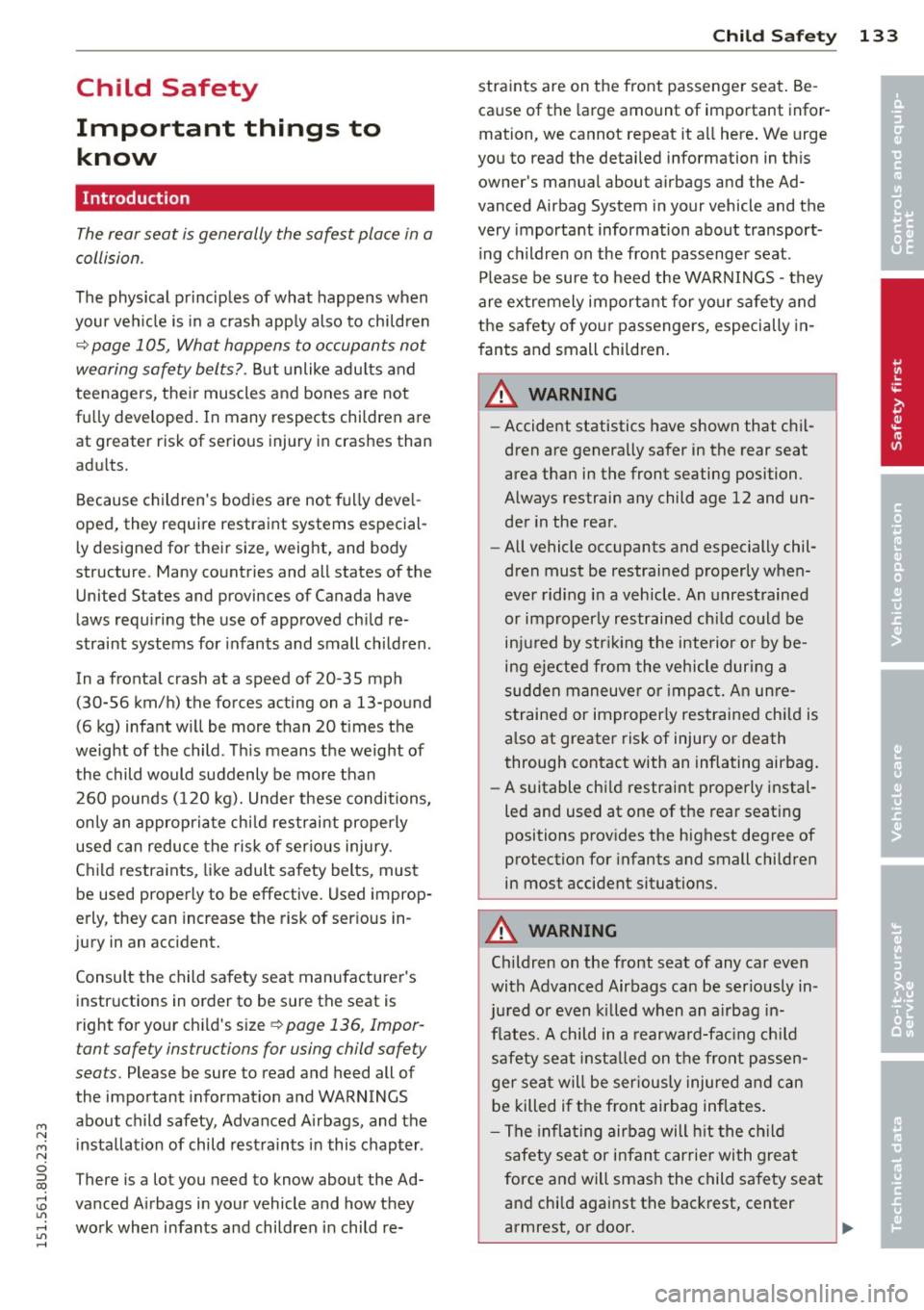
M N
M N
0 ::i co ,...., \!) 1.1"1 ,...., 1.1"1 ,....,
Child Safety
Important things to know
Introduction
The rear seat is generally the safest place in a
collision .
The physical principles of what happens when
your veh icle is in a crash app ly also to chi ldren
~ page 105, What happens to occupants not
wearing safety belts? .
But unlike adults and
teenagers, their muscles and bones are not
fu lly developed. In many respects children are
at greater risk of serious injury in crashes than
adu lts.
Because children's bodies are not fully deve l
oped, they require restraint systems especial ly designed for their size, weight, and body
structure. Many countries and all states of the
United States and provinces of Canada have
laws requiring the use of approved child re
straint systems for infants and small children .
In a fronta l crash at a speed of 20 -35 mph
(30-56 km/h) the forces acting on a 13-pound
(6 kg) infant w ill be more than 20 t imes the
weight of the child . This means the weight of
the child would suddenly be more than
260 pounds (120 kg). Under these conditions,
on ly an appropriate chi ld restraint properly
used can reduce the risk of ser ious injury .
Child restra ints, like adult safety belts, must
be used properly to be effective. Used improp
erly, they can increase the risk of serious in
jury in an accident.
Consult the child safety seat manufacturer's
instructions in order to be sure the seat is
right for your chi ld's size ~
page 136, Impor
tant safety instructions for using child safety
seats.
Please be sure to read and heed all of
the important information and WARNINGS
about ch ild safety, Advanced A irbags, and the
installation of child restraints in this chapter.
There is a lot you need to know about the Ad
vanced Airbags in your vehicle and how they work when infants and children in child re-
Child Sa fet y 133
straints are on the front passenger seat . Be
cause of the large amount of important infor
mation, we cannot repeat it a ll here . We urge
you to read the detailed information in this owner's manual about airbags and the Ad
vanced Airbag System in your vehicle and the
very important information about transport
ing children on the front passenger seat .
Please be sure to heed the WARNINGS -they
are extremely important for your safety and
the safety of your passengers, especially in
fants and small chi ldren .
.A, WARNING
-Accident statistics have shown that chil
dren are generally safer in the rear seat
area than in the front seating position.
Always restrain any child age 12 and un der in the rear.
- All vehicle occupants and especially chil
dren must be restrained properly when
ever riding in a vehicle . An unrestrained
or improperly restrained chi ld could be
injured by str ikin g the interior or by be
ing ejected from the vehicle during a
sudden maneuver or impact. An un re
strained or improper ly restrained chi ld is
also at greater risk of injury or death
through contact with an inflating airbag.
- A suitable chi ld restraint properly instal
led and used at one of the rear seating
positions provides the highest degree of
protection for infants and small children
in most accident situations.
A WARNING
Children on the front seat of any car even
with Advanced Airbags can be ser iously in
jured or even killed when an a irbag in
flates. A child in a rearward-facing child
safety seat installed on the front passen
ger seat will be ser iously injured and can
be killed if the front airbag inflates .
- The inflating airbag will h it the child
safety seat or infant carrier with great
force and will smash the child safety seat
and child against the backrest, center
armrest, or door.
•
•
Page 136 of 258
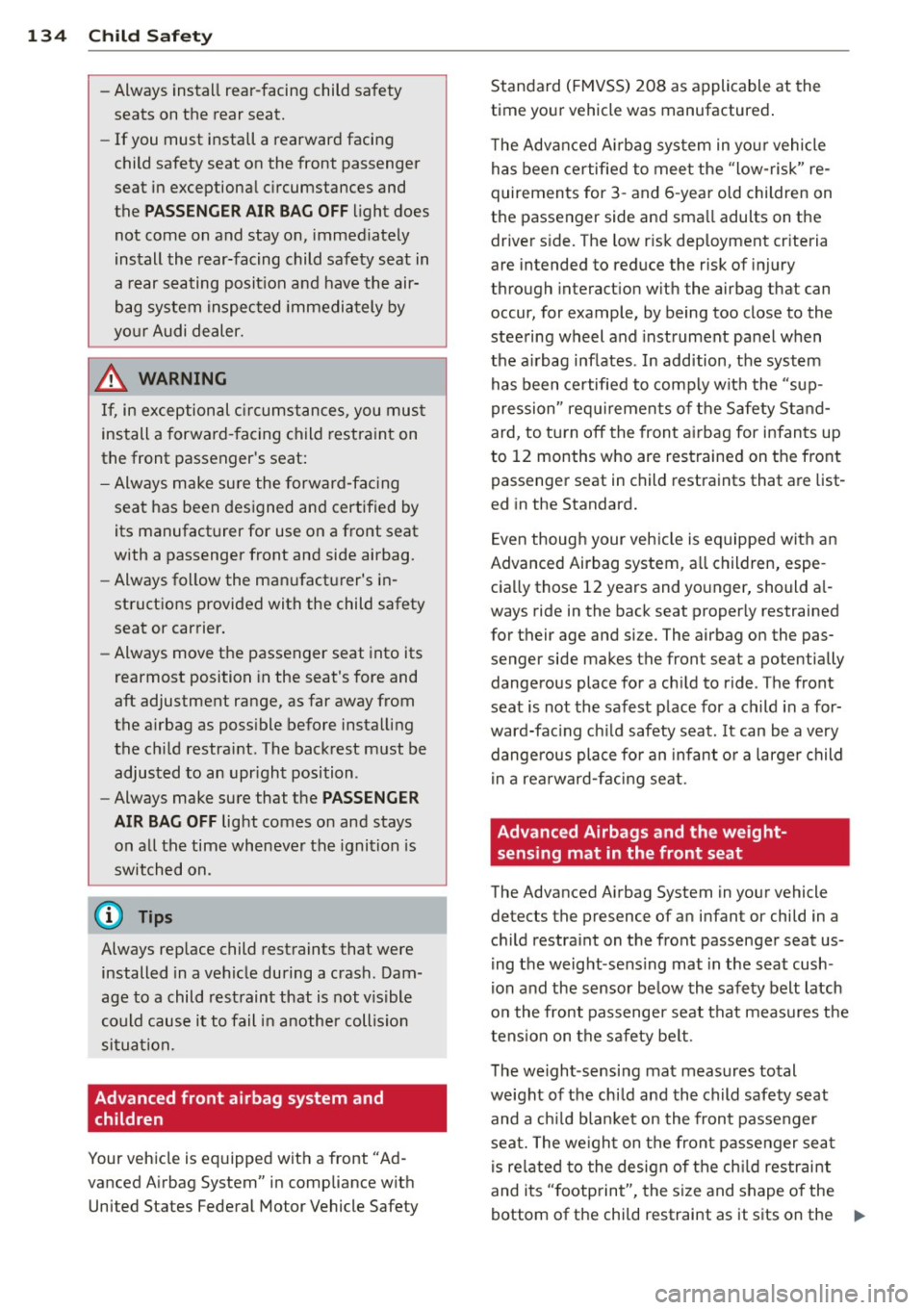
134 Child Safety
-Always install rear-facing child safety
seats on the rear seat.
- If you must install a rearward facing
child safety seat on the front passenger
seat in exceptional circumstances and
the
PASSENGER AIR BAG OFF light does
not come on and stay on, immediately
install the rear-facing child safety seat in
a rear seating position and have the air
bag system inspected immediately by
your Audi dealer.
_& WARNING
If, in exceptional circumstances, you must
install a forward-facing child restraint on
the front passenger's seat:
- Always make sure the forward-facing
seat has been designed and certified by
its manufacturer for use on a front seat
with a passenger front and side airbag.
- Always follow the manufacturer's in
structions provided with the child safety
seat or carrier.
- Always move the passenger seat into its
rearmost position in the seat's fore and
aft adjustment range, as far away from
the airbag as possible before installing
the child restraint. The backrest must be
adjusted to an upright position .
- Always make sure that the
PASSENGER
AIR BAG OFF
light comes on and stays
on all the time whenever the ignition is
switched on.
(D Tips
Always replace child restraints that were
installed in a vehicle during a crash. Dam
age to a child restraint that is not visible
could cause it to fail in another collision
situation.
Advanced front airbag system and children
Your vehicle is equipped with a front "Ad
vanced Airbag System" in compliance with United States Federal Motor Vehicle Safety Standard (FMVSS) 208 as applicable at the
time your vehicle was manufactured.
The Advanced Airbag system in your vehicle
has been certified to meet the "low-risk" re
quirements for 3- and 6-year old children on
the passenger side and small adults on th e
driver side. The low ris k deployment criteria
are intended to reduce the risk of injury
through interact ion with the airbag t hat can
occur, for example, by being too close to the
steering wheel and instrument panel when
the airbag inflates . In addition, the system
has been certified to comply with the "sup
pression" requirements of the Safety Stand
ard, to turn off the front airbag for infants up
to 12 months who are restrained on the front
passenger seat in child restraints that are list
ed in the Standard.
Even though your vehicle is equipped with an
Advanced Airbag system , all children, espe
cially those 12 years and younger, should al
ways ride in the back seat properly restrained
for their age and size. The airbag on the pas
senger side makes the front seat a potentially
dangerous place for a child to ride . The front
seat is not the safest place for a child in a for
ward-facing child safety seat. It can be a very
dangerous place for an infant or a larger child
in a rearward-facing seat .
Advanced Airbags and the weight
sensing mat in the front seat
The Advanced Airbag System in your vehicle
detects the presence of an infant or child in a
child restraint on the front passenger seat us
ing the weight-sensing mat in the seat cush
ion and the sensor below the safety belt latch
on the front passenger seat that measures the
tension on the safety belt.
The weight -sensing mat measures total
weight of the child and the child safety seat
and a child blanket on the front passenger
seat. The weight on the front passenger seat
is related to the design of the child restraint
and its "footprint", the size and shape of the
bottom of the child restraint as it sits on the .,..
Page 137 of 258
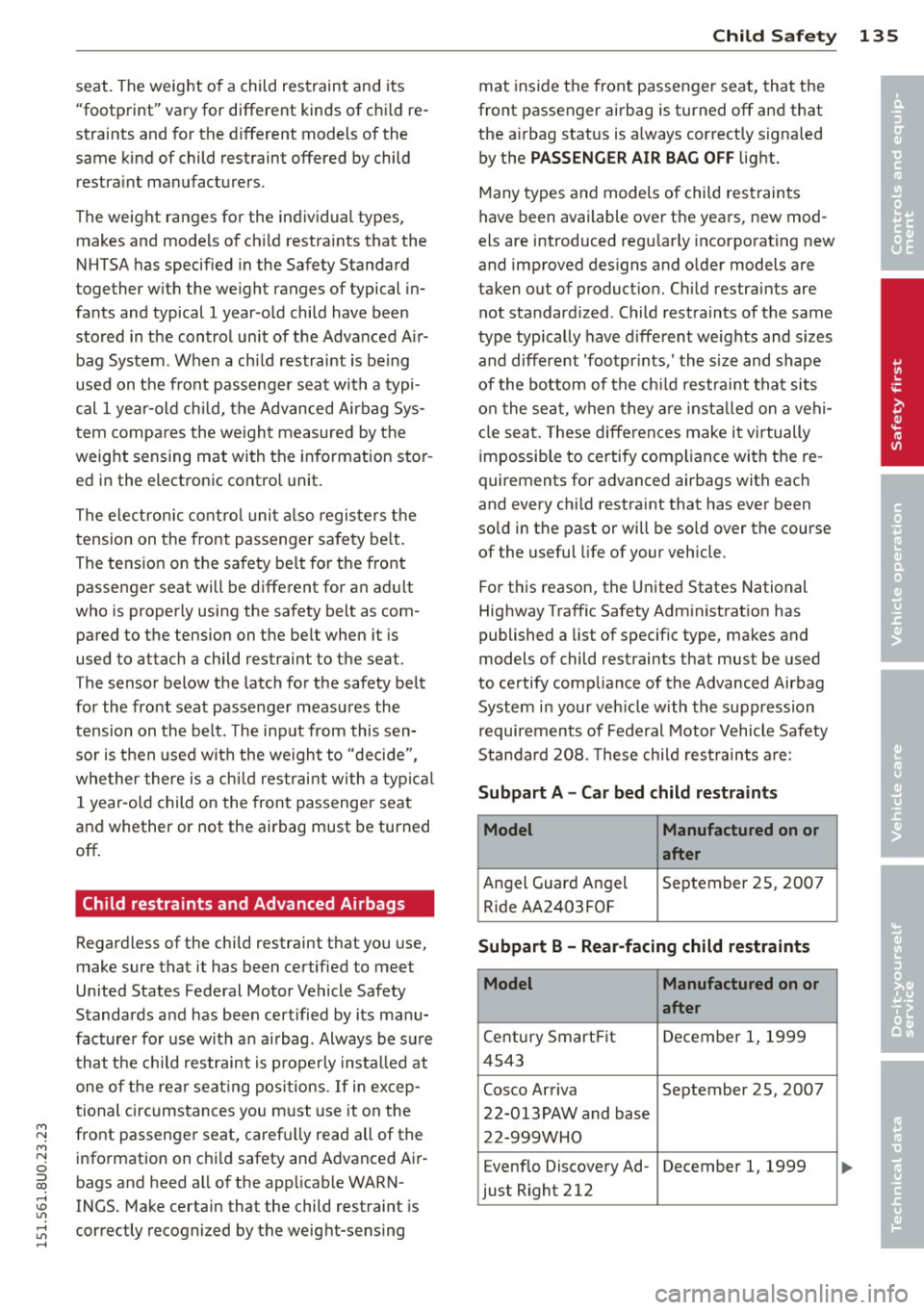
M N
M N
0 ::i co ,...., \!) ..,.,
,...., ..,., ,....,
seat. The weight of a child restraint and its
"footprint" vary for different kinds of child re
straints and for the different models of the
same kind of child restraint offered by child restra int manufacturers.
The weight ranges for the individual types, makes and mode ls of ch ild restra ints that the
NHTSA has specified in the Safety Standard
together with the we ight ranges of typical in
fants and typical 1 year-old child have been
stored in the control unit of the Advanced A ir
bag System. When a chi ld restraint is being
used on the front passenge r seat with a typi
cal 1 year -old ch ild, the A dvanced Airbag Sys
tem compares the we ight measured by the
weight sensing mat with the information stor
ed in the electronic control unit.
The electron ic contro l unit al so registers the
tension on the front passenger safety be lt.
The tension on the safety be lt for the front
passenger seat will be different for an adult
who is properly using the safety belt as com
pared to the tension on the be lt when it is
used to attach a child restraint to the seat.
The sensor below the latch for the safety belt
for the front seat passenger measures the
tension on the belt. The input from this sen
sor is t hen used w ith the we ight to "decide",
whether there is a ch ild restraint with a typ ica l
1 year-o ld child on the front passenger seat
and whether or not the airbag must be turned
off .
Child restraints and Advanced Airbags
Regard less of the child restraint that you use,
make sure that it has been certified to meet
United States Federal Motor Vehicle Safety
Standards and has been certified by its manu
facturer for use with an airbag . Always be sure
that the chi ld restraint is p roperly instal led at
one of the rear seat ing pos itions. If in excep
tional ci rcumstances you must use it on the
front passenger seat, carefu lly read all of the
information on child safety and Advanced Air
bags and heed a ll of the app licable WARN
INGS. Make certain that the child restraint is
correctly recognized by the weight-sensing
Child Sa fet y 135
mat inside the front passenger seat, that the
front passenger airbag is turned off and that
the a irbag status is always correct ly signaled
by the
PAS SENGE R AIR BAG OFF light.
Many types and models of child restraints
have been available over t he years, new mod
els are introduced regu larly incorporating new
and improved des igns and o lder models are
taken out of product ion. Ch ild restraints are
not standard ized . Child restraints of the same
type typ ically have d ifferent weights and sizes
and different 'footpr ints,' the size and shape
of the bottom of the ch ild restrai nt that sits
o n the seat, when they a re insta lled on a veh i
cle seat. These diffe rences make it v irtually
impossible to certify compliance with the re
quirements for advanced airbags with each
and every ch ild restraint that has ever been
sold in the past or will be sold over the course
of the useful life of your veh icle.
For this reason, the United States National
Highway Traffic Safety Adm inistrat ion has
published a list of spec ific type, makes and
models of child restraints that must be used
to certify comp liance of the Advanced Airbag
System in your veh icle with the suppression
requirements of Federal Motor Vehicle Safety
Standa rd 208. These chi ld restraints are:
Subpart A - Car bed child restraints
Model Manufactured on or
after
Angel Guard Angel September 25, 2007 R ide AA 2403FOF
Subpart B - Rear-facing child restraints
Model Manufactured on or
after
Century Smart Fit December 1, 1999
4543
Cosco Arriva September 25, 2007 22-013PAW and base
22-999WHO
Evenflo Discovery Ad- December 1, 1999
just Right 212
•
•
Page 138 of 258
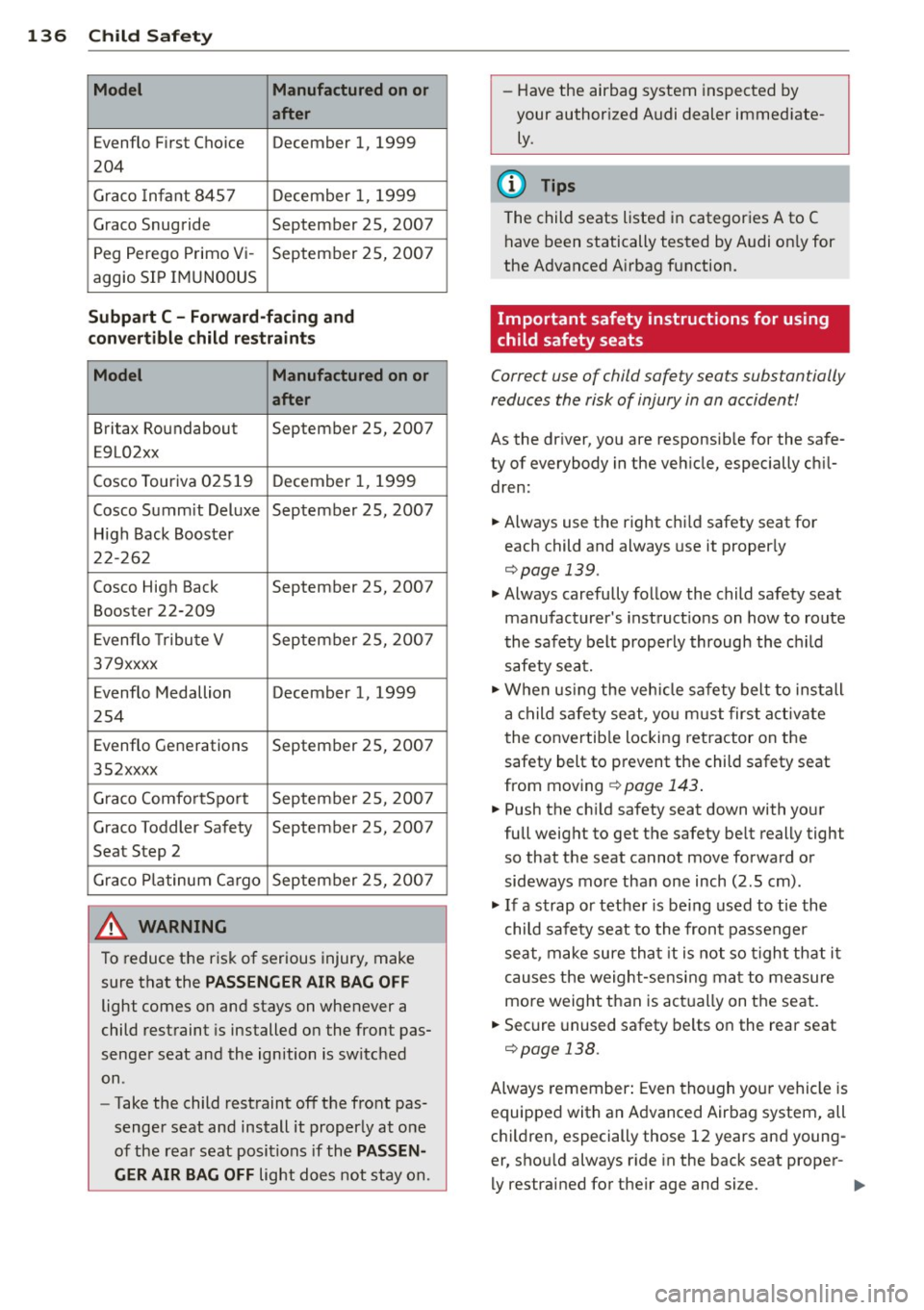
136 Child Safety
Model Manufactured on or
after
Evenflo First Choice December 1, 1999
204
Graco Infant 8457 December 1, 1999
Graco Snugride September 25, 2007
Peg Perego Primo Vi- September 25, 2007
aggio SIP IMUN00US
Subpart C - Forward-facing and
convertible child restraints
Model Manufactured on or
after
Britax Roundabout September 25, 2007
E9L02xx
Cosco Touriva 02519 December 1,
1999
Cosco Summit Deluxe September 25, 2007
High Back Booster
22-262
Cosco High Back September 25, 2007 Booster 22-209
Evenflo Tribute V September 25, 2007
379xxxx
Evenflo Medallion December 1, 1999
254
Evenflo Generations September 25, 2007
352xxxx
Graco Comfo rtSport September 25, 2007
Graco Toddler Safety September 25, 2007
Seat Step 2
Graco Platinum Cargo September 25, 2007
A WARNING
To reduce the risk of serious injury, make
sure that the
PASSENGER AIR BAG OFF
light comes on and stays on whenever a
child restraint is installed on the front pas
senger seat and the ignition is switched
on.
- Take the child restraint off the front pas
senger seat and install it properly at one
of the rear seat positions if the
PASSEN
GER AIR BAG OFF
light does not stay on. -
Have the airbag system inspected by
your authorized Audi dealer immed iate
ly.
@ Tips
The child seats listed in categories A to C
have been statically tested by Audi only for
the Advanced Airbag function.
Important safety instructions for using
child safety seats
Correct use of child safety seats substantially
reduces the risk of injury in an accident!
As the driver, you are responsib le for the safe
ty of everybody in the veh icle, especially chil
dren:
.. Always use the right chi ld safety seat for
each child and always use it properly
c::;,page 139.
.. Always carefully follow the child safety seat
manufacturer's instruct ions on how to route
the safety belt properly through the child
safety seat .
.. When using the vehicle safety belt to install
a child safety seat, you must first activate
the convertible locking retractor on the
safety belt to prevent the child safety seat
from moving
¢ page 143 .
.. Push the ch ild safety seat down with your
full weight to get the safety belt really tight
so that the seat cannot move forward or
sideways more than one inch (2 .5 cm) .
.,. If a strap or tether is be ing used to tie the
child safety seat to the front passenger
seat , make sure that it is not so tight that it
causes the weight-sensing mat to measure
more weight than is actually on the seat.
.. Secure unused safety belts on the rear seat
c::;, page 13 8.
Always remember: Even though your vehicle is
equipped with an Advanced Airbag system, all
children, especially those 12 years and young
er, shou ld always ride in the back seat proper-
ly restrained for their age and size . .,.
Page 139 of 258
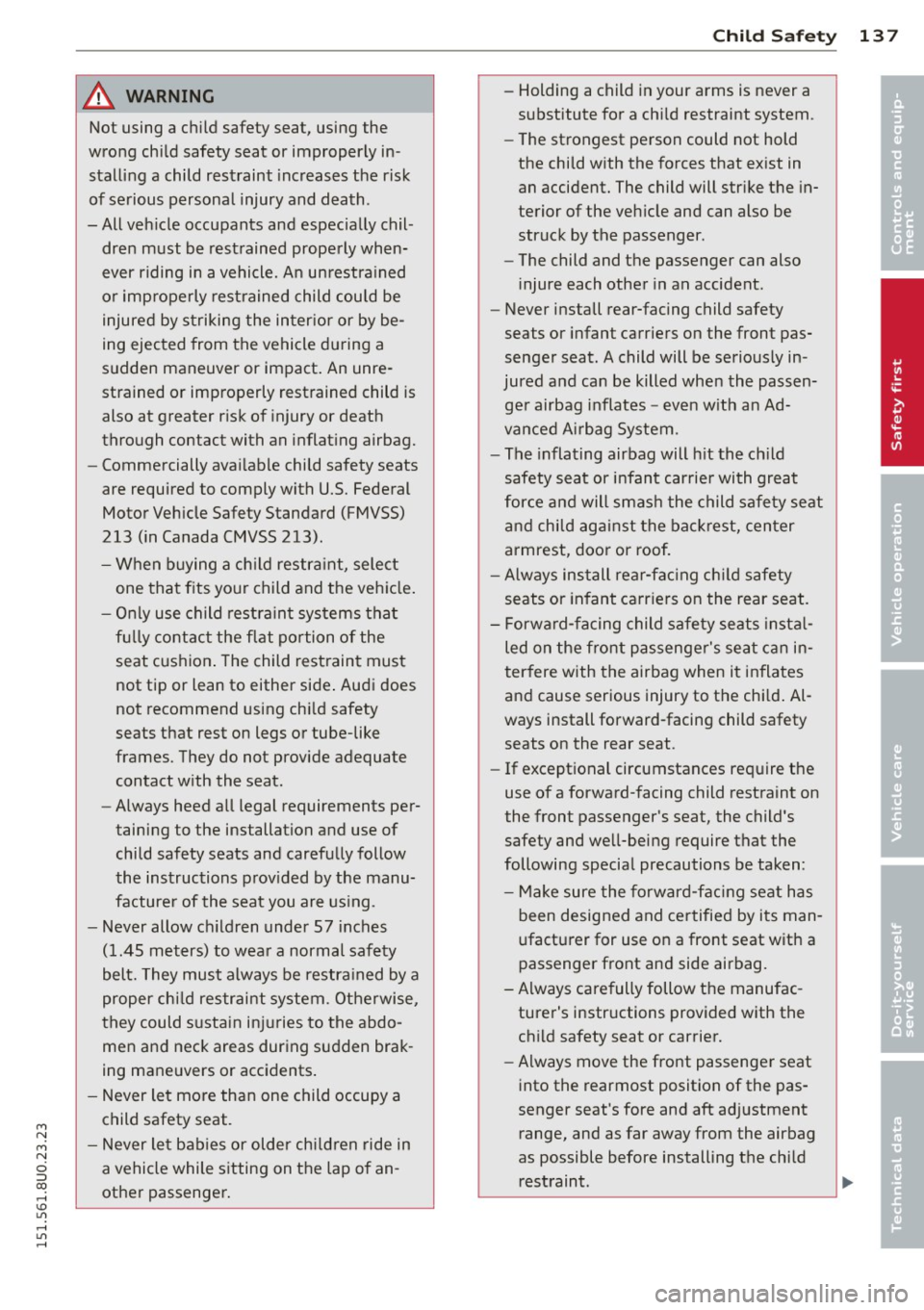
M N
M N
0 ::i co ,...., \!) 1.1'1 ,...., 1.1'1 ,....,
A WARNING 1-=
Not using a child safety seat, using the
wrong child safety seat or improperly in
stalling a child restraint increases the risk
of serious personal injury and death .
-All vehicle occupants and especially chil dren must be restrained properly when
ever riding in a vehicle. An unrestrained
or improperly restrained child could be
injured by striking the interior or by be
ing ejected from the vehicle during a
sudden maneuver or impact. An unre
strained or improperly restrained child is
also at greater risk of injury or death
through contact with an inflating airbag.
- Commercially available child safety seats
are required to comply with U.S. Federal
Motor Vehicle Safety Standard (FMVSS)
213 (in Canada CMVSS 213) .
- When buying a child restraint, select
one that fits your child and the vehicle.
- Only use child restraint systems that
fully contact the flat portion of the seat cushion . The child restraint must
not tip or lean to either side . Audi does
not recommend using child safety
seats that rest on legs or tube-like
frames . They do not provide adequate
contact with the seat.
- Always heed all legal requirements per
taining to the installation and use of child safety seats and carefully follow
the instructions provided by the manu facturer of the seat you are using.
- Never allow children under S7 inches
(1.45 meters) to wear a normal safety
belt. They must always be restrained by a
proper child restraint system. Otherwise,
they could sustain injuries to the abdo
men and neck areas during sudden brak
ing maneuvers or accidents.
- Never let more than one child occupy a
child safety seat.
- Never let babies or older children ride in
a vehicle while sitting on the lap of an
other passenger.
Child Safety 137
- Holding a child in your arms is never a
substitute for a child restraint system .
- The strongest person could not hold
the child with the forces that exist in
an accident. The child will strike the in
terior of the vehicle and can also be
struck by the passenger.
- The child and the passenger can also
injure each other in an accident .
- Never install rear-facing child safety
seats or infant carriers on the front pas
senger seat. A child will be seriously in
jured and can be killed when the passen ger airbag inflates -even with an Ad
vanced Airbag System.
- The inflating airbag will hit the child
safety seat or infant carrier with great
force and will smash the child safety seat
and child against the backrest, center
armrest, door or roof.
- Always install rear-facing child safety
seats or infant carriers on the rear seat.
- Forward-facing child safety seats instal
led on the front passenger's seat can in
terfere with the airbag when it inflates
and cause serious injury to the child. Al
ways install forward-facing child safety seats on the rear seat .
- If exceptional circumstances require the
use of a forward-facing child restraint on
the front passenger's seat, the child's
safety and well-being require that the
following special precautions be taken:
- Make sure the forward-facing seat has
been designed and certified by its man
ufacturer for use on a front seat with a
passenger front and side airbag.
- Always carefully follow the manufac turer's instructions provided with the
child safety seat or carrier.
- Always
move the front passenger seat
into the rearmost position of the pas
senger seat's fore and aft adjustment
range, and as far away from the airbag
as possible before installing the child restraint.
.___ ____________ _J ...
•
•
Page 140 of 258
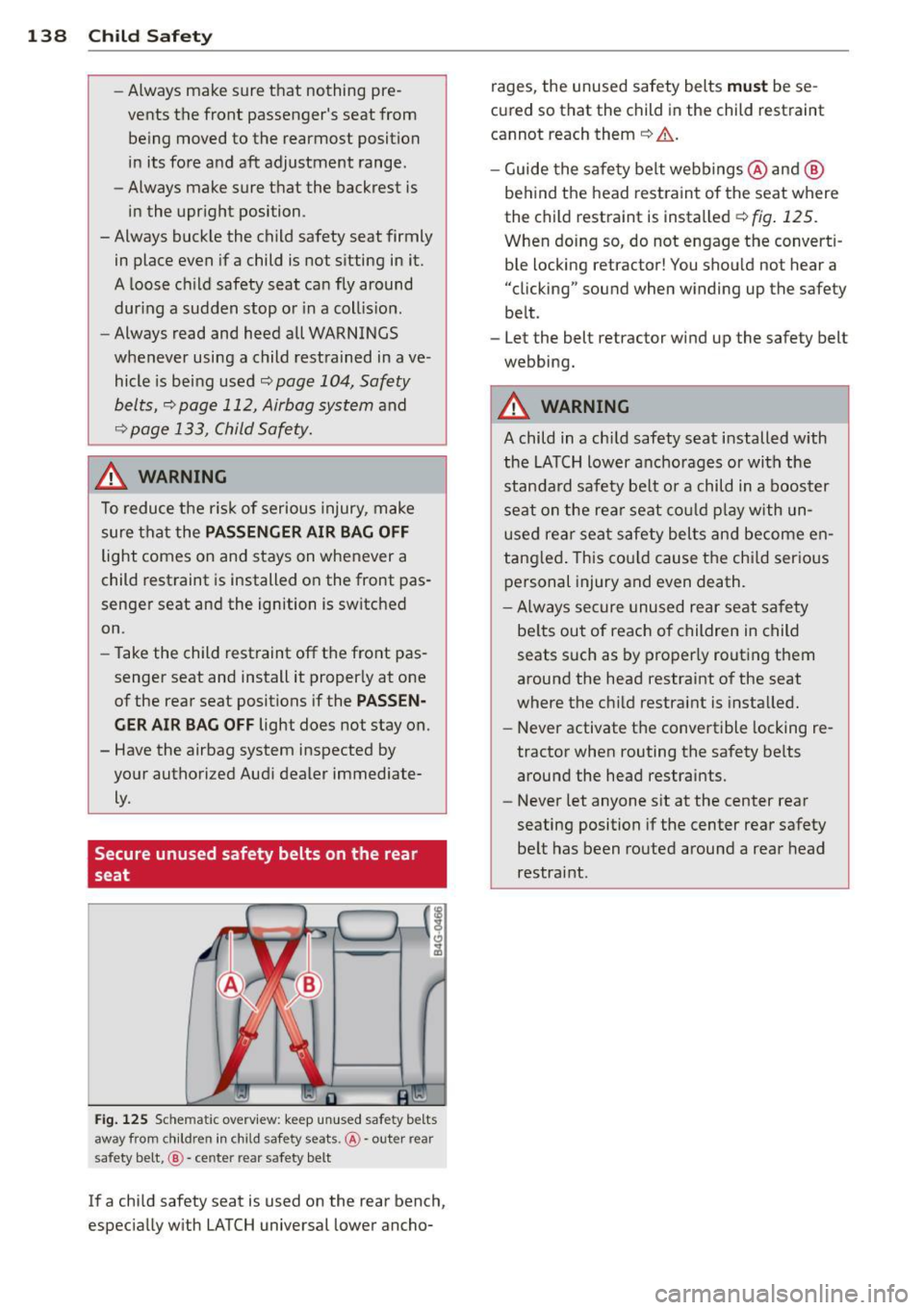
138 Child Safet y
-Always make sure that nothing pre
vents the front passenger's seat from being moved to the rearmost position
in its fore and aft adjustment range.
- Always make sure that the backrest is
in the upright position.
- Always buckle the child safety seat firmly
in place even if a child is not sitting in it.
A loose ch ild safety seat can fly around
dur ing a sudden stop o r in a collis ion.
- Always read and heed all WARNINGS
whenever using a child restrained in ave
hicle is being used .:;,
page 104, Safety
belts, .:;,page 112, Airbag system
and
~ page 133, Child Safety.
_& WARNING
To reduce the risk of serious injury, make
sure that the
PA SSENGER AI R BAG OFF
light comes on and stays on whenever a
child restraint is installed on the front pas
senger seat and the ignition is switched
on.
- Take the child restraint off the front pas
senger seat and install it proper ly at one
of the rear seat positions if the
PASSEN
GER AIR BAG OFF
light does not stay on.
- Have the airbag system inspected by
your authorized Audi dealer immediate
ly.
Secure unused safety belts on the rear
seat
Fig . 125 Schematic overview: keep un used safety belts
away from children in child sa fety seats. ®· outer rear
safety belt,
@ -center rear safety belt
.
If a chi ld safety seat is used on the rear bench,
especially w ith LATCH universal lower ancho- rages, the unused safety belts
mu
st be se
cured so that the child in the child restraint
cannot reach them .:;,
&..
-Guide the safety belt webbings @and @
behind the head rest raint of the seat where
the child restraint is installed
<::;,fig . 125.
When doing so, do not engage the converti
ble locking retractor! You shou ld not hear a
"clicking" sound when winding up the safety
belt .
- Let the belt retractor wind up the safety belt
webbing.
_& WARNING
=
A child in a child safety seat installed with
the LATCH lower anchorages or with the
standa rd safety be lt or a child in a booster
seat on the rea r seat co uld p lay with un
used rear seat safety belts and become en
tang led . This cou ld cause the chi ld serious
personal injury and even death.
- Always secure unused rear seat sa fety
be lts out of reach of children in child
seats such as by proper ly routing them
around the head restraint of the seat
where the child restraint is installed.
- Never activate the convertible locking re
tractor when routing the safety be lts
around the head restraints.
- Never let anyone sit at the center rear
seating position if the center rear safety
be lt has been routed around a rear head
restraint.